Saint Petersburg Mining University
Saint Petersburg Mining University (Russian: Санкт-Петербургский горный университет), is Russia's oldest technical university,[2] and one of the oldest technical colleges in Europe. It was founded on October 21, 1773, by Empress Catherine the Great, who realised an idea proposed by Peter the Great and Mikhail Lomonosov for training engineers for the mining and metals industries. Having a strong engineering profession was seen by many Russian rulers as a vital means of maintaining Russia's status as a great power. As historian Alfred J. Rieber[3] wrote, "The marriage of technology and central state power had a natural attraction for Peter the Great and his successors, particularly Paul I, Alexander I and Nicholas I".[4] All three had had a military education and seen the achievements of the engineers of revolutionary and imperial France, who had reconstructed the great highways, unified the waterways and erected buildings throughout Europe in a more lasting tribute to the French than all of Napoleon's victories.[5]
Санкт-Петербургский горный университет | |
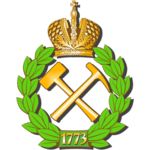 | |
Former names | Leningrad Mining Institute National Mineral Resources University |
|---|---|
| Motto | Усердие к услуге Отечества и к пользе оного любовь |
Motto in English | Diligence in conducting the affairs of the Fatherland and love for the good thereof[1] |
| Type | Public |
| Established | 1773 |
| Rector | Vladimir Litvinenko |
Academic staff | 5,000 |
| Students | 16,500 |
| Location | , |
| Website | spmi |
Building details | |
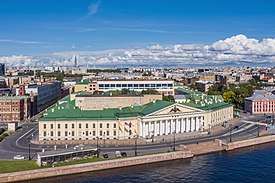 The building of the Mining Academy (1811) is a Neoclassical masterpiece by Andrey Voronikhin. | |
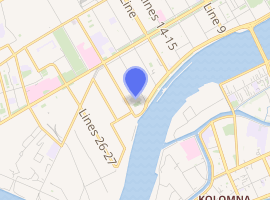
| |
| General information | |
| Estimated completion | 1811 |

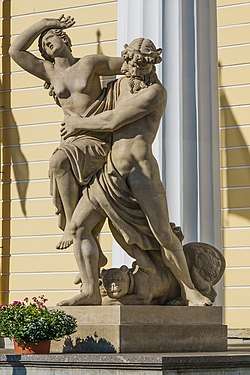
Though located in St. Petersburg, the university is on a federal rather than local level, and has partnerships with global oil, gas and mining companies and governments. Its museum[6] is home to one of the world's finest collections of gem and mineral samples and the university building is a Neoclassical masterpiece by Andrey Voronikhin.
History
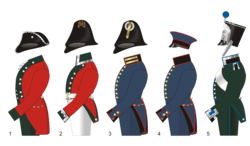
1. Lecturer of the Mining School, 1794
2. Cadet (Unteroffizier) of the Mining Cadet Corps, 1804
3. Student (senior pupil) of the Mining Institute, 1833–1834
4. Junior pupil of the Mining Institute, 1833–1834
5. Cadet (Unteroffizier) of the Institute of the Corps of Mining Engineers, 1834–1848
The university was first known as the Mining School (Горное училище) until 1804, when it became the Mining Cadet Corps (Горный кадетский корпус); in 1833, it became the Institute of the Corps of Mining Engineers (Институт корпуса горных инженеров). Since 1866, it was known as the Mining Institute (Горный институт). It is still widely known in Russia as 'Gorny', or 'Mining', referring to its previous name. During the Soviet period, it was renamed after Georgi Plekhanov, who attended the institute in the 1870s, and became known as the G. V. Plekhanov Leningrad State Mining Institute and Technical University. In 1958–1960 a branch of the institute was opened in Vorkuta and night schools at Slantsy, Monchegorsk, and Kirovsk. Since 1869 the institute has also been the headquarters of the Russian Mineralogical Society.
During the Siege of Leningrad, the building was used as a manufacturing base for producing explosives and grenades.
The university also houses a church, St Macarius of Egypt,[7] which first opened its doors in 1805. It was closed together with other churches by the Soviet government in 1918, and used as a cinema and then a gym, resulting in damage to the interior, but in 1996 was recognised once more as a church and restored fully. It is now a working church.
The university was renamed Saint Petersburg State Mining University in 2011, and, after merging with the North-West Open Technical University in 2012, it was known as the National Mineral Resources University. The university was renamed Saint Petersburg Mining University in 2016.
Building
The university is housed in a grand neoclassicist building with a 12-column portico on the banks of the Neva River, on the south shore of Vasilievsky Island. It is the first building that can be seen from ships travelling into the city from the Gulf of Finland, and is a prime example of the monumental neoclassicist style favoured in Imperial Russia in the early 1800s. Russian scholars call this architecture classicist, while in the west it is defined as neoclassicist, because trends in architecture came to Russia later than in the West.
Architect Andrey Voronikhin completed the building in 1806–11. He also designed the Kazan Cathedral – inspired by St. Peter's Basilica in Rome – at Nevsky Prospect, as well as buildings at Paul I's estate at Pavlovsk Palace south of the city. he also remodelled the interiors of the baroque Stroganov Palace in neoclassical style. The design of the university building reflects the idea that mining is a harsh and difficult pursuit – as well as symbolising the entry into the underground world of Pluto through the portico, decorated with 12 columns of the Doric order.[8]
On the left-hand side of the steps at the entrance to the university is a sculpture by Vasily Demut-Malinovsky, who designed decorations and sculptures for many of the city’s churches, palaces and monuments. The Abduction of Proserpina depicts how the Roman goddess Proserpina is seized and taken to the underworld by Pluto, and is after the original The Rape of Proserpina by Italian artist Gian Lorenzo Bernini (1621–22), which provided the inspiration for many artists. Its powerful forms and heavy proportions[9] are determined by its position and function as a decoration of the huge portico, and the sculpture together with the portico are typical of Russian town planning in the beginning of the 19th century.[9]
One the right-hand-side of the entrance to the university is the Hercules and Antaeus sculpture by Stepan Pimenov,[10] one of the leading Russian sculptors of the early 19th century, who also created sculptural decorations for the Kazan Cathedral, the Admiralty, and many other palaces and monuments in St Petersburg, and who had worked closely with Demut-Malinovsky since 1802. Hercules and Antaeus shows how Hercules won in a struggle with Antaeus, who had defeated most of his previous opponents up to that point.
In 1830 Pimenov fell out of favour with Tsar Nicholas I, seemingly over his sculptures to decorate the Narva Triumphal Arch, built in 1814 to mark the Russian victory over Napoleon, but most probably because of his portraits of the Tsar, which Nicholas did not take a liking to.[11]
Pimenov was dismissed by the Tsar and died three years later, at the age of 49.
The two sculptures symbolise the earth, its power and wealth – Antaeus’ strength lay in his contact with Mother Earth, and Demut-Malinovsky’s Rape of Proserpina also shows a struggle – and the dynamism of each sculpture contrasts with the solidity of the large portico.[12]
Traditions
Unusually for a non-military establishment, the university has a uniform worn by all staff and students. When it was first opened in the 1700s, students wore a double-breasted red uniform with a white collar and gold trimmings. The uniform was dropped for a number of years before being reintroduced in 2000 with the aim of reviving the traditions of Russia's first technical college. The Russian railways is another non-military organisation where staff still wear a uniform.[13] In 2013, Russia began issuing new sets of stamps showing uniforms[14] such as those of communications and post office workers, from the 1600s to the present. Russian mining engineers in general wore uniforms, seemingly as part of efforts to bring the profession closer to the military.[15]
Science
One of the key achievements of the university's scientists has been the invention of techniques to drill through several miles of Antarctic ice to reach the sub-glacial Lake Vostok. Professor Nikolai Vasiliev, head of the drilling department at the university,[16] has led the drilling efforts, while scientific research into the layers of ice that cover the lake, the possibility of new forms of microbial life existing in the lake, and a host of other areas of research connected to the lake are based at the Arctic and Antarctic Research Institute, the Petersburg Nuclear Physics Institute, the All-Russian Research Institute of Geology and Mineral Resources of the World Ocean (VNIIOkeangeologia), the Institute of Geography in Moscow, the Limnological Institute in Irkutsk and the Laboratory for Glaciology and Environmental Geophysics in Grenoble, France. Lake Vostok is one of the world's most closely watched scientific projects, and the expertise of the Russian drillers, directed by Professor Vasiliev, is recognised.[17]
Controversies
Vladimir Litvinenko, who has been rector since 1994 and has close links to Vladimir Putin, who defended his doctoral thesis at the institute in 1996. Litvinenko oversaw Putin's work, which is alleged to include significant amounts of plagiarism and is speculated perhaps to have not even been written by Putin (i.e. that he paid somebody to write it for him). Litvinenko has been criticised for not spotting the plagiarism.[18]
References
- Sorokin, Vladimir. "Preserving the historical memory". National Mineral Resources University. Archived from the original on January 4, 2017. Retrieved March 3, 2016.
- "History". National Mineral Resources University. Archived from the original on March 6, 2016. Retrieved March 3, 2016.
- Central European University website, Alfred. J. Reiber http://people.ceu.hu/alfred-j_rieber
- The rise of engineers in Russia, Cahiers du monde russe et soviétique, http://monderusse.revues.org. Vol. 31, Issue 4, p. 539 - 568, 1990
- The rise of engineers in Russia, Cahiers du monde russe et soviétique, http://monderusse.revues.org. Vol. 31, Issue 4, pp. 539–568, 1990
- The Mining Museum homepage on the university homepage, with details of how to visit "Archived copy". Archived from the original on 2014-11-09. Retrieved 2014-12-02.CS1 maint: archived copy as title (link)
- Venerable Macarius the Great of Egypt http://oca.org/saints/lives/2014/01/19/100226-venerable-macarius-the-great-of-egypt
- Ленинградский Горный Институт 1773–1973. The Leningrad Mining Institute, 1773–1973 (in Russian), p.3, 1973, Leningrad.
- "Vasily Demut-Malinovsky (1779–1846)". welcomeart.net. WelcomeArt Oil Paintings Gallery. Archived from the original on March 10, 2016. Retrieved December 2, 2014.
- "Stepan Pimenov (1784–1833)". welcomeart.net. WelcomeArt Oil Paintings Gallery. Archived from the original on March 10, 2016. Retrieved December 2, 2014. Retrieved 11 November 2014
- "Энциклопедии » 100 ВЕЛИКИХ СКУЛЬПТОРОВ » СТЕПАН СТЕПАНОВИЧ ПИМЕНОВ" Encyclopaedia of 100 Great Sculptors: Stepan Stepanovich Pimenov (in Russian). Retrieved 20 November 2014. murzim.ru.
- St. Petersburg Architecture, http://stpetersburgrussia.ru/Architecture/mining_institute
- Russian Railways Museum, St Petersburg http://railway-museum.ru/en/gallery/16.html?setcookies=yes
- The History of the Russian Uniform (ongoing stamp series) at Wikimedia Commons
- Uniforms of the Mines Administration from 1745 to 1855, by Leonid Shepelëv, Tseikhgauz history journal (Russia) http://www.xenophon-mil.org/rusarmy/arsenal/uniforms%20of%20mines.htm
- Lagnado, Alice (5 December 2013). "Antarctica - the white magnet for Russian scientists," Voice of Russia. Retrieved 2 December 2014. "Archived copy". Archived from the original on 2014-12-02. Retrieved 2014-12-02.CS1 maint: archived copy as title (link)
- Jean Jouzel, Claude Lorius & Dominique Raynaud, The White Planet: The Evolution and Future of Our Frozen World. Princeton University Press, 2013, p.101. http://press.princeton.edu/titles/9823.html.
- "It All Boils Down to Plagiarism". Cdi.org. 2006-03-31. Archived from the original on 2009-08-06. Retrieved 2010-03-02. Clifford Gaddy: "Mr. Litvinenko -- who was directly involved in the dissertation, allegedly helped [Putin] choose the topic and was more or less the adviser for the dissertation -- is himself a member of the higher accreditation commission, which is the government-appointed body to be the watchdog over standards about degree-granting, dissertations and quality control for higher education in Russia. So it’s extra scandalous that he would be involved in this case of, at minimum, shoddiness and plagiarism, possibly something worse, which would be the literal purchase, either by money or political influence, of a dissertation by someone who didn’t actually do the work. That second point is not clear. I don’t have proof about that. All I have is proof about the plagiarism."
External links
| Wikimedia Commons has media related to Saint Petersburg Mining University. |